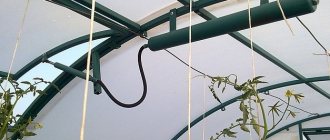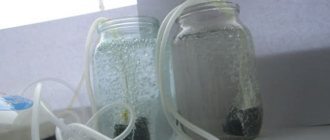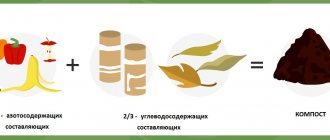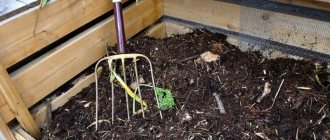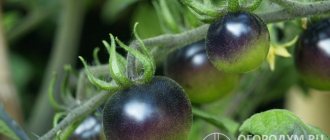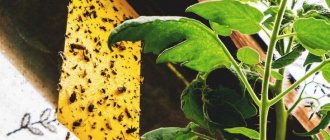28.02.2017
For the harvest, the gardener has to compete with the vagaries of the weather and with parasitic insects. Tomato lovers get it from the black midge or, as it is also called, the country aphid or leafhopper. If you don’t get rid of it in time, the tomato midge will destroy the beds with tomatoes.
- Damage from black midges
- How to get rid of black midges on tomatoes
- How to get rid of black midges on tomato seedlings
Pest identification
It is quite easy to detect such a small parasite on foliage.
Just look at the general condition of the tomato bushes. If you are a conscientious owner, you water and loosen your garden on time, as well as timely processing and fertilizing, but the tomatoes still look withered and lethargic, you should pay attention to the underside of the leaves.
Aphids and their larvae most often occupy the top of the plant, devouring young tender foliage. Another sure sign that there are aphids in your garden is the appearance of ants. For them, aphids are an excellent source of essential sugars.
There are different types of aphids, but the most dangerous are the winged ones, which are capable of flying long distances in a short time. The parasite feeds on the juice of young tomato foliage, and at such a rate of reproduction it can cause significant harm to the plant and even destroy it.
Aphids not only eat the plant and suck out the juices necessary for development, but they can also infect it with various viral diseases. In addition, the ability to bear fruit is significantly reduced in an adult plant. After all, along with the foliage, the aphids also eat the flowers, from which the ovary eventually appears.
Below is a photo of black midge aphids on tomatoes; as soon as this pest is identified on the bushes of the plant, measures should be taken immediately to destroy it.
Types and signs of parasitism
Small insects can cause irreparable damage to crops both outdoors and in the greenhouse. You should inspect the plants daily, paying especially close attention to young seedlings, which quickly die when attacked by midges of any variety.
On tomatoes, two similar species are most often found - white aphids and black aphids. They differ in color and body structure, but they cause equally strong damage. To determine the infestation and take action in time, the easiest way is to shake the tomato bush, then the midge will fly into the air.
White midges whiteflies
On the bottom of the leaf it is easy to notice small white flies - these are whiteflies. They have transparent wings, the body is less than 3 mm. These insects jump and fly well, so they quickly infect plantings.
Most often this pest appears in greenhouses, although it is also found in open plantings. Like other types of aphids, the whitefly sucks the juices from the plant, resulting in curling of the leaves, drying out of individual parts, falling flowers, or the absence of ovaries on tomatoes altogether. In addition, black or brown spots appear.
Black
Black midges on tomatoes are common and multiply incredibly quickly. Tomato aphids are a little different, as there are many varieties. Regardless of the presence of wings or size, the insect quickly destroys the plantings and the plants die.
Dark midges are much smaller, their body grows no more than 2 mm in length, and up to 5 generations of insects are born in one season. Aphids lay eggs for the winter in old bark, foliage, and other secluded places. At the same time, they are not afraid of frost. In the spring, larvae hatch from the clutch, develop quickly, and reproduce without fertilization at high speed.
Methods to combat black midges
If there are too many midges, then this method will be useless and you will have to consider other methods.
Use of chemicals
You can fight black midges on tomatoes using chemicals that are sold in stores. It is better to choose mild pesticides and insecticides of organic origin. Preparations based on vegetable oils and fatty acids are considered the safest.
The most common remedies are “Aktafit”, Aktara”, “Fufanon”. The solution for spraying must be prepared according to the attached instructions, observing the dosage. It is necessary to carry out at least three procedures for processing tomatoes, with a break of 5-7 days between them.
But during the period of fruit ripening, it is undesirable to spray plants with chemicals. In this case, folk methods of fighting aphids will come to the rescue.
Folk remedies
This arsenal of tools is quite wide and has been tested by more than one generation. These methods allow you to effectively combat black midges on tomatoes, while they are absolutely harmless to human health.
Basic Recipes
- You will need a bag of hot red pepper, 3 large cloves of garlic (chopped) and 3 tbsp. l. mustard powder. All ingredients need to be mixed, add 5 liters of warm water and leave for 3 days. This solution is used to spray tomato stems and the soil around them.
- 200 gr. Pour 3 liters of boiling water over onion peels and let the broth brew. When the product has cooled, you can spray the bushes completely.
- You need to prepare a soap solution by diluting 20 grams of laundry soap in 10 liters of warm water. Then add a glass of ash to it and mix everything thoroughly. The stems and leaves of plants need to be treated with this product.
- You can collect tomato leaves (healthy plants) and prepare a decoction based on them. You will need 2 tbsp. crushed leaves, they need to be filled with 2 tbsp. hot water and leave for 12 hours. Then the bushes affected by midges are treated with this product.
But it should be remembered that the positive effect of these products decreases sharply immediately after the first watering or rain.
General information and damage from insects
There are several species of midges that are not averse to eating tomatoes.
The main enemies of the culture are black and white midges. Each of them has its own characteristics. The second name for black midge is soil fly or winged aphid. An adult grows up to 2, sometimes up to 4 mm in length. It has a black body and transparent wings. It reproduces in moist soil enriched with organic matter. The larvae live in the upper layers of the soil. After pupation, they cause harm by eating the roots of nearby plants. Adults feed on the sap of cultivated and weed seedlings, hiding on the underside of the leaves. A large number of black midges on tomatoes leads to wilting of plants, stunted growth and lack of fruiting.
Black midges on a tomato leaf
White midges on tomatoes are small whitefly moths. Insects grow up to 3 mm. Midge larvae are laid on the bottom of leaves and on stems. This allows them to maintain their vital functions by saturating the plant with juice and nutrients. After such an invasion, the greens and fruits of tomatoes are damaged and begin to turn black. Even a drop in temperature does not lead to the death of pests. They overwinter in the top layer of soil.
Midges reproduce quickly enough to cause unique damage to plantings in a short time. In addition, pests are carriers of viruses and leave on tomatoes a favorable environment for the proliferation of fungi. Failure to take timely measures to destroy insects will lead to the loss of almost half of the crop.
How to destroy black midges using folk methods?
Since the treatment of tomatoes and other crops with chemicals during fruit ripening is undesirable, most summer residents prefer to destroy midges using traditional methods.
The following are very popular among farmers:
- decoction of celandine;
- dandelion tincture;
- mustard, red pepper and garlic;
- vinegar solution.
A decoction of celandine quickly kills black midges. It must be made from green leaves and branches of the plant.
- Collect 400 g of raw materials, fill it with 1 liter of water and leave for a day. When the liquid is infused, put it on the fire and boil for 30 minutes on a minimum flame.
- Turn off, let the broth cool on its own, strain through a piece of gauze and dilute the infusion in 10 liters of water.
- Place the liquid in the cellar for 2 days and spray each tomato bush 2-3 times at intervals of 5 days.
Black winged and wingless midges do not tolerate dandelion juice, so it can be used to make an excellent remedy for its destruction. Collect 1 kg of roots and leaves of the plant, pour 10 liters of boiling water over them, cover with a lid and leave for a day, placing it closer to heat. To improve the infusion's ability to repel midges, add 1 tbsp. l. red pepper and the same amount of grated laundry soap. Use to treat tomatoes and the soil around them.
Pepper, mustard and garlic are natural poisons for pests. To prepare the product, peel 5 large cloves of garlic, grind them in a mortar and combine with 20 g of ground red pepper and 3 tbsp. l. mustard powder. Pour the components into 5 liters of water at room temperature and leave for at least 3 days. Then strain and sprinkle the solution on each plant and the ground underneath it.
The acidic environment provided by table vinegar is detrimental to midges. But in order not to burn the tender leaves of the tomatoes, the solution should be made of a weak consistency. 1 tbsp will be enough. l. per liter of water.
Whitefly specimen
Dangerous pests: fungus gnat and white midge
If you notice that the leaves of your plants have turned yellow and started to fall off, it is quite possible that the vegetables have become a victim of white midges (whiteflies). In order to prevent the development of white midges, it is necessary to take measures to eliminate the favorable environment for them.
They love to attack seedlings and whiteflies
Firstly, be sure to maintain the distance between plants; you cannot plant seedlings too densely. Secondly, watering should be moderate - the permissible moisture levels should not be exceeded. And thirdly, use only proven, high-quality fertilizers - do not use expired fertilizers or those whose origin you are not sure of. Factory packaging with the date of manufacture and instructions can be a guarantee of quality.
Remember - in greenhouses and apartments, white midges can reproduce regardless of weather conditions and time of year. You can encounter them even in winter.
White midges quietly develop in greenhouses and apartments even in winter
A good way to get rid of white midges is a tincture of tobacco leaves. To do this, take a pack of cigarettes, remove the tobacco (of course, you need to remove it from the paper and filter), fill it with hot water (about a liter per pack) and leave in a dark place for about five days. The strained solution is used for watering plants every 3-4 days. Soon you won't see any pests.
Another dangerous pest is the fungus gnat. They usually fly in small groups and lay their eggs directly in the ground. The larvae of these insects are especially dangerous for seedlings.
Fungus mosquitoes are also dangerous because they can lay eggs directly in the soil where the seedlings grow.
There are separate means to destroy fungus gnat larvae. They are applied under the top layer of soil and are usually sold in granules. After watering, the granules will dissolve and the product will begin to act.
Fungus gnats and fruit flies
In closed greenhouses, you can use sulfur candles to fumigate the room.
How to properly set fire to a sulfur bomb
Insecticides containing pyrethrum and pirimiphos-methyl work well.
It is important to follow the instructions for use of various products
How to deal with the pest?
It’s easy to defeat the pest at home; the main thing is to do the procedure in a timely manner, treat all parts of the plant, not only the foliage, but also the trunk. For a greenhouse, control methods are practically the same.
Chemicals
The most common chemical control method is spraying. There are a large number of different drugs that will help cope with black aphids. You need to spray tomatoes against black midges according to the instructions on the packaging, which are present on any preparation.
Systemic chemical products will be most effective; it is best to use enteric contact agents Aktaru and Decis.
Specialized means
Insect control can be more severe or using gentle insecticides of organic origin. To treat tomatoes, preparations based on vegetable oils and acids are used. The most popular among them are Fitoverm, Aktafit.
When handling, it is important to strictly follow safety precautions by wearing gloves and a respirator. Repeat spraying twice, taking weekly breaks between them. During the tomato ripening period, plants are not treated with chemicals.
During the tomato ripening period, the plants are not treated with chemicals.
Folk recipes
If time is not lost, the aphids have not spread much on the plants, then folk remedies may well help. The treatment will have to be carried out several times, but this will protect the future harvest from the effects of chemicals.
Treatment with soap and ash are the most universal methods of combating aphids. To do this, you need to dissolve 20 g of laundry soap shavings and ¼ kg of tree ash in a bucket of warm water. Then thoroughly spray with this solution, even rinse individual areas of the plants. If you dissolve 1 tbsp. l. table vinegar 9% in a liter of water, you will also get a good solution for fighting insects on tomatoes. The following composition is infused for about three days: dissolve 2 tbsp in a bucket of hot water. l. red chili pepper, 6 tbsp. l. dry mustard, two chopped heads of garlic
This method involves bathing tomato tops in a solution; it is especially important to treat the lower part of the plants. Taking 4 kg of celandine branches, you need to fill them with a bucket of water, leave for a day, then bring to a boil, steam over low heat for half an hour. Strain the mixture, dilute 1 liter of decoction with 10 liters of water
After another two days, spray the diseased plants; repeat only after a week.
Long-term preparation of folk remedies leads to the fact that during this period the pests spread greatly. Preference should be given to quick ways to solve the problem.
Fumigation of greenhouses
Fumigation can only be done in a greenhouse; this method will not give results in the fresh air. Sulfur is used for combustion; 1 m3 requires 200 g of dry matter. After the procedure, the greenhouse must be closed for at least 4 days. Not only the aphid dies, but also the tomato mosquito. Carry out processing strictly after harvesting.
Biological drugs
Treatment with biological agents is safe for humans, but the result of exposure is somewhat different
One important condition distinguishes them from chemical ones - that it is permissible to pick and eat the fruits after treatment after 2 days. Also, biological products are harmless to animals and bees.
The maximum result of their use will be visible after a week.
Entobacterin helps destroy insects at high air temperatures, which is an advantage for the southern regions of the country. And 50 species of different pests die from its influence. The drug Strela will destroy a large number of pests in just 2 days.
Every year, many different biological products appear that help fight pests.
What herbs will help get rid of parasites?
Treatment will not be useful if you plant the necessary herbs next to the tomatoes that can repel pests. Flowering strongly scented plants such as fennel, peppermint or basil will repel aphids. It is useful to sow garlic or cilantro between rows of tomatoes; marigolds will help in the fight against aphids.
Prevention
Pests will appear less often in the garden if you use simple prevention methods:
- regular autumn removal of weeds from the site;
- digging up the earth;
- escape in a greenhouse by fumigation with sulfur;
- removal of anthills;
- attracting ladybugs, wasps;
- attracting birds;
- planting useful plants between tomato rows.
Advice! It is important not to flood the plants, and not to overheat the air in greenhouses.
To preserve the harvest, it is important to regularly inspect the bushes, find pests, and take a responsible approach to their removal. Various preventive measures and therapeutic agents are used to help get rid of black midges or whiteflies on tomatoes.
Video "Struggle"
From the video you will learn how to fight aphids.
If you notice that a black midge has appeared on tomatoes growing in your beds, then get ready to fight for the harvest - you have been visited by aphids, one of the most famous and dangerous pests of garden and vegetable plants. Don't be surprised by their appearance - black midges with or without transparent wings are one of the subspecies of the well-known aphid. The only difference is in appearance. It will harm the plant no less than its more famous “sister”, which has a pale green color - it will suck out the juices, while actively multiplying and increasing its ranks, which is why the plant will die. Having destroyed the affected plant, the aphid will move to the neighboring one, and thus destroy all available bushes.
How to get rid of black midges?
There are several ways to fight. The first, most accessible, is to destroy aphids with your own hands, without the use of auxiliary means. If insects have not yet infested your garden, and you observe small clusters of them, try washing them off with a stream of water from a hose or remove them by hand, examining each bush. On bushes, including tomatoes, black midges have the largest concentrations on the underside of leaves.
Another method that does not require costs is to destroy aphids, “using the services” of other insects that feed on them, and small birds. Some wasps, lacewings, hoverflies and ladybugs are not averse to feasting on aphids. Contrary to popular belief, ants do not eat aphids. On the contrary, they protect it, using it as a source of food - a sweetish liquid that aphids secrete when eating young leaves of plants. To attract aphids in the fight against aphids, plant fragrant herbs. Unfortunately, this method is also effective only if you find black midges on tomatoes in small quantities.
One of the best ways to prevent aphid invasion is to plant plants in the beds so that crops on which this insect does not settle alternate with varieties that are interesting to it. For example, garlic and onions repel aphids.
If there are large numbers of black midges on tomatoes, you will still have to fight it using various chemicals by spraying the leaves of the plant with them. You can use special commercially produced aphid control products. To avoid harming the plant, it is better to use milder organic pesticides and insecticides. For example, products based on vegetable oils, fatty acids or pyrethrins. In addition, you can create such products yourself, using substances available in every home.
If there are black midges on tomatoes in your garden, then prepare the products described above and treat the plants with them every few days until the pest completely disappears. Do not forget that the described preparations can destroy not only the pest, but also beneficial insects, so it is better to do the treatment in the evening, when the insects that pollinate your plants have already finished their work.
A midge that appears on tomatoes requires a prompt response from the gardener. Even at the initial stage of its development, this parasite poses a serious threat to seedlings and future harvests. Regardless of the type of parasite that attacked the greenhouse or vegetable garden, the gardener will have to fight aphids. Before taking any action, it is necessary to study the situation. Ill-considered actions pose a greater danger than the insect itself.
How dangerous are insects?
In addition to the fact that black flies on tomatoes in a greenhouse or open ground are capable of sucking out all the juices, curling the leaves, and destroying the ovaries, they can infect all plants with other dangerous diseases.
Young plants are most susceptible to attack; they have not yet grown strong, and the roots have not gained strength. Fungal and bacterial infections, along with aphids, will completely destroy the plant.
Parasites are dangerous for tomatoes not only in adulthood. At the larval stage, they secrete a sticky, waxy liquid that prevents the plant from developing normally. As a result, it becomes more difficult to control aphids.
For an adult, strong tomato bush, aphids are not so terrible; it is difficult for the insect to bite through the hardened parts of the plant. However, mature fruits may suffer and develop unsightly black spots caused by insect waste.
Why are there small midges in indoor flowers?
It is important not to forget that excessively moist soil is the best place for midges to exist and reproduce.
So, if you do not want to breed white bugs in the soil of indoor plants, then you should not neglect attention to the soil in pots
Secondary reasons for the appearance of harmful insects include:
- Pouring low-quality soil into flower pots. It leads to an invasion of harmful midges, the larvae of which will already live in the soil. As a result, you will need to quickly look for ways to get rid of the emerging parasites.
- The appearance of insects can be facilitated by transplanting plants into huge pots. The soil at the bottom of the flower pot is most saturated with moisture, only the root system of the plant does not reach there. High humidity is a suitable breeding ground for pests.
- The use of organic fertilizers will also encourage the appearance of bugs. Even if the soil is watered moderately, the presence of organic impurities will attract midges, which will settle well on the indoor plant.
- A fly can fly into an apartment from another living space, from the basement, through ventilation or an exhaust pipe. Moreover, the flying insects immediately find suitable flower pots with abundantly moistened soil.
Signs of pests on plants
If you notice that the seedlings have wilted, the leaves of cucumbers and tomatoes have curled and become deformed - this is an attack by insects. Many people mistakenly think that the plants have withered due to lack of moisture and begin to water them abundantly. However, after watering the condition of the seedlings does not improve.
If insects attacked for a long time, the stems and leaves become covered with dark spots and dry out over time. Therefore, it is imperative to inspect the plants.
In most cases, small pests can be found on the lower surface of the leaves and at their base.
An inexperienced gardener may not immediately see them, therefore the inspection must be carried out during the day, in sunlight.
Even if you do not find pests on one wilting plant, be sure to inspect all the seedlings and treat them for prevention. This will ensure that individuals that you may not have noticed will be destroyed.
In addition, pay attention to ant trails near the garden bed - this is also a sign of the appearance of harmful insects. After all, ants love to feast on the sweet liquid that aphids secrete.
Therefore, if a large number of goosebumps scurry along the stems of a plant, this is a 100% indicator that this particular bush has been attacked the most.
How to get rid of midges using folk remedies
It is not always possible to dry the soil quickly, and the number of larvae in the ground may be such that it will be impossible to delay. Then you will have to transplant the plants into new soil, other pots or boxes, having first sterilized everything. Simultaneously with transplantation, measures must be taken to destroy adult flying individuals.
You can start by using an electric flying insect killer or a fumigator with mosquito and fly repellent. If the seedlings are located in a place where there is no electrical wiring, then it is necessary to hang sticky fly traps in the nursery or set fire to a mosquito coil.
The preparation of soil for transplanting seedlings must be taken with full responsibility. It is not enough to simply buy soil mixture at a garden store and pour boiling water over it. You need to put it in the microwave for 2-3 minutes or fry it in the oven for 20-30 minutes. If this cannot be done, then to the treatment of the land with boiling water, add subsequent treatment with water with potassium permanganate diluted in it. The color of the water should be deep pink. Boxes, trays, pots and tools that will be used during transplantation are subject to disinfection.
Before transplanting seedlings into it, the soil must be dried until it becomes a crumbling lump in your hands.
To prevent eggs and larvae of pests from getting into the fresh soil again, the roots of the plant and the lower parts of the stems are freed from the soil, dipped for 3-5 seconds in a weak solution of potassium permanganate and carefully inspected.
If there are no pots in which to transplant the plants, you can replace only the top 2-3 cm of soil on the surface of the pot. A few granules of soil insecticide are added to the new layer of soil. After this, a layer of drainage materials 1 cm thick is laid on the soil surface.
What it is?
Aphids are tiny, soft-bodied insects. The body is pear-shaped and reaches a length of 0.5-1.0 mm. Depending on age, individuals can be winged or wingless. Pests love to feast on young tomato leaves: they contain a large amount of juice and a low proportion of coarse fiber.
Aphids are able to camouflage themselves into their environment. The plant pigment, along with the juice, enters the insect’s body, and the body turns a different color, most often pale green.
The life cycle of aphids occurs as follows:
- In autumn, winged fertilized females lay eggs on wild radish, rapeseed, and cabbage stalks. The embryos survive the winter safely.
- In warm spring, larvae appear. They begin to eat young shoots.
- After molting, the process of asexual reproduction begins. The result of this stage is the appearance of wingless females. They provide new growth to the colony through the birth of new larvae.
- Around mid-summer, winged individuals appear. Here, a small part of the pests begin to experience a significant lack of food, which leads to their death. There is a strong increase in new colonies.
- At the end of summer, winged representatives of different sexes appear. At this stage, mating occurs. Females lay eggs. Colonies die. The cycle repeats.
Reference! Scientists have proven that in just 30 days of asexual reproduction, one female is capable of producing 2-3 generations of small individuals. The brood size exceeds 10 thousand.
Signs of aphids are curled leaves, greens and shoots covered with sticky sweet secretions. It is clear that the invasion of unpleasant pests does not benefit young tomatoes.
There are midges in the seedlings, what to do?
Midges feel great where it’s warm, where leftover food is rotting in a garbage bag, pieces of fruit are lying around out of sight, or compote is turning sour in a cup. But, if everywhere is clean and dry, midges have to look for a place where they can find food and lay eggs.
They will always find the conditions necessary for their nutrition and reproduction on the surface of a waterlogged soil substrate in a box with seedlings. Therefore, the first thing that needs to be done to deprive insects of their breeding places is to dry the soil under the plants.
Do not water the seedlings until the top layer of soil dries out. If it happens that after watering the earthen ball becomes too wet, you need to try to dry it quickly, for example, by placing pots with seedlings over heat sources. You have to be careful not to cook the plants.
If excess water drains into the lower pan, the liquid will need to be drained so that it does not rise through the bottom of the container to the upper part of the pot again. Then watering can be done through this pan by adding water into it.
Reasons for the appearance of aphids on seedlings
As a rule, whiteflies infest seedlings. But black midges can also appear, even though they are outdoor insects. Pests also thrive indoors, entering through windows.
In addition, midges can also come to seedlings from indoor plants if they are infested with insects.
The most common reason for the appearance of aphids in the soil is excessive moisture.
Frequent watering helps create favorable conditions for the development of aphid larvae. Very often, midges are found in purchased soil and are invisible to humans, therefore, the parasites can be seen only when they have managed to actively spread on the plants.
Midges in tomato seedlings: how to get rid of them
White flies on tomatoes are not afraid of chemicals, but, nevertheless, there are effective ways to combat them:
- fumigation;
- biological methods;
- traditional methods;
- preventive measures.
Fumigation with sulfur bombs in a greenhouse helps get rid of not only midges, but also their offspring. This method is best combined with the use of insecticides and chemicals, such as Confidor extra, Aktara, Pegasus, Fosbecid. It is recommended to spray twice to ensure that the pest is destroyed. Treatment activities are carried out in warm, dry weather; after spraying, the bushes are covered to create shade. It is better to re-treat with another drug in order to destroy insects that are immune to the first drug.
Important! Chemical treatment should not be carried out during flowering and fruit formation. The biological method is considered the most gentle option
It can be used even during flowering and fruit formation. The method is based on involving in the fight the natural enemies of the whitefly - encarsia, which is an entomophagous insect that parasitizes the eggs of the white midge. To start a “war”, parasite pupae are placed on cardboard sheets near a bush, from where they move onto plants and infect whitefly larvae
The biological method is considered the most gentle option. It can be used even during flowering and fruit formation. The method is based on involving in the fight the natural enemies of the whitefly - encarsia, which is an entomophagous insect that parasitizes the eggs of the white midge. To start a “war,” the parasite pupae are placed on cardboard sheets near the bush, from where they move onto the plants and infect the whitefly larvae.
An example of folk remedies is hardening. Pests do not like low temperatures, so if possible, you need to take the seedlings to a cool place more often if the whitefly is infested on the window.
Fishing with glue
Traps with glue have a good effect. To do this, apply glue to scraps of plywood or cardboard painted yellow and place the trap on the bush. You can use fly tape instead.
Another excellent folk remedy is to wipe the leaves with infusions of garlic, yarrow or soap solution. Add 150 g of chopped garlic cloves to 1 liter of water and leave for 5 days. Next, add another 6 liters of water to the concentrate and spray the plants.
To make a soap solution, a piece of laundry or tar soap is grated and diluted with water until liquid, and then the bushes are thoroughly treated using a sprayer. This product can be applied repeatedly.
However, it is better to prevent the appearance of midges than to rack your brains about how to get rid of them later.
Therefore, it is important to use preventive measures from the first days of planting seeds for seedlings:
- ventilate the room where young tomato bushes stand more often;
- carry out disinfection;
- dig up the area more often, especially before planting seedlings;
- Do not store compost at home, which is a bait for whiteflies.
Measures to save seedlings
If black midge appears on tomato seedlings, then you urgently need to spray the plants with Proteus. Careful treatment of the bushes with folk remedies will help, this will be an infusion of herbs or tobacco, as well as ash or iodine.
Carefully inspect the area and surrounding area; if you find an anthill, remove it immediately. This can be easily done using boiling water or hot ash. There are many ways to fight ants; it is better to use several of them at the same time.
Interesting! In a greenhouse, the best method is fumigation or mechanical removal (in cases where there are few insects).
How to get rid of black midges on tomatoes
Small accumulations of insects are removed by hand or washed off with a hose. However, midges multiply quickly, and manual work is unlikely to save the bushes. Let's look at how to get rid of black midges on tomatoes.
Method No. 1
Midges cannot tolerate liquid or laundry soap. To treat the stems and leaves of plants, one of three types of soap solutions is prepared:
- Two large spoons of liquid product are diluted in 500 ml of water and diluted with a glass of sunflower oil.
- Twenty grams of laundry soap are crushed and dissolved in ten liters of hot water. Add a glass of ash there.
- Liquid soap (two large spoons) is dissolved in 500 ml of water, crushed garlic (five cloves) and a little sunflower oil are added. Leave for 60 minutes, filter.
Vinegar is also used to kill midges on tomatoes: an acidic environment is destructive for parasites. Tomatoes should be sprayed with a weak solution so as not to burn the tender shoots (a large spoon of nine percent vinegar per liter of water).
Method No. 2
Infusions based on pungent plants will help you cope with annoying parasites. Black midges on tomatoes will die if you spray the plants:
- Garlic-pepper composition. It will require three cloves of garlic, twenty grams of hot crushed pepper, three large spoons of mustard powder. Dissolve the ingredients in five liters of water and filter after 72 hours.
- A decoction of onion peels. 200 grams of the component are steamed in three liters of boiling water. After cooling, filter.
- Infusion of celandine. Green shoots (400 grams) are poured with a liter of water for 24 hours, then put on low heat and simmered for half an hour. Filter and dilute in a ten-liter container with water. After two days of infusion in the dark and cool, it is used for spraying. You can repeat the treatment after five days.
- Tomato leaf remedy. Healthy leaves are cut and infused in 500 ml of water. Treatment is carried out 12 hours after filling with water.
- Dandelion juice. Dandelion leaves and roots are steamed with boiling water in a ratio of 1:10. Keep in a warm place for 24 hours. Add a little red pepper and crushed laundry soap to the composition.
If black midges appear on tomatoes, spray the plants themselves and the ground around them with herbal infusions.
Such products contain a high concentration of burning substances. They effectively cope with midges, but can also harm plants. To avoid this, follow the recipe.
Method No. 3
If home remedies don't help, you can try another method. If there are an abundance of insects, you will have to use chemicals - mild pesticides and organic insecticides, which are sold in gardening stores. Safe products are those based on fatty acids, vegetable oils and pyrethrins.
Use against black midge:
- Aktafit;
- Fufanon;
- Aktar.
Each product comes with instructions for how to prepare the solution. Tomato bushes are treated three times with an interval of five days. Specialized stores and centers for gardeners will also tell you how to treat tomatoes against midges.
Chemicals should not be used when tomatoes have already begun to ripen.
Any of the compositions - homemade or store-bought - is used in the morning and evening, before and after the appearance of bees and other pollinating insects. Rain can reduce the effect of spraying plants.
Life cycle and distribution
Due to their rapid reproduction, midges can produce up to 5 generations in one season. Thanks to the ability of some species to fly, they easily move from one bush to another and so on throughout all tomato beds. The life cycle of whiteflies depends on the presence of ants nearby. At night, anthills provide shelter for pests. This is where they lay their eggs. White midges do not have good flight ability, but in case of danger they can quickly move to a more secluded place, where they accumulate in large numbers.
Insects lay eggs in the spring, when the ground has warmed up sufficiently. White midges breed on tomatoes in a greenhouse all year round. The larvae are born within a week after laying. Having found a secluded place, they pupate and within two weeks become invulnerable to chemicals and other treatments. After a while, adult individuals emerge from the cocoons and begin active reproduction. The full development cycle is 25 days, and the lifespan of one female is about 30 days. During her life she manages to lay about 140 eggs.
Whitefly butterfly
How to spray correctly?
In order for the drugs to have the expected effect during processing, several rules must be followed:
- All plants will have to be sprayed: sick and healthy.
- Work should be carried out in the morning or evening hours, when direct rays of the sun do not fall on the plants.
- Processing must be carried out at a temperature not lower than 18 degrees, otherwise the effect of many drugs disappears.
- For maximum effect, it is recommended to add liquid potassium soap to the solution.
- You need to spray the entire plant, both leaves and stem, trying to get on the inside of the leaf.
- When treating with drugs such as Vertimek, Actelik, Fitoferm, Agravertin, the seedlings should be carefully covered with plastic wrap for several hours.
Black midge
In addition to whiteflies, other insects can also parasitize greenery, so you should be wary of the appearance of uninvited dark-colored “guests” in the leaves of plants. The black midge that appears on tomatoes, just like the white-winged midge, feeds on the juice of the stems and leaves, actively destroying the plant.
Signs of presence on tomatoes
If black pests begin to multiply on tomatoes, you can notice the following changes that have occurred in the plants:
- leaves look lifeless and dry, despite regular watering;
- stunted appearance of stems;
- poor yield or complete loss of the diseased plant’s ability to bear fruit;
- the appearance of ant trails that protect black midges, feeding on their waste products.
Very often insects can be seen with the naked eye, especially on a sunny day - they like to sit on the bottom of leaves and eat succulent areas.
To stop the “feast” of parasites and protect your plants, you will need to treat them and fight insects as soon as possible.
Natural repellents
An excellent option for preventing aphid infestations would be plants with a repulsive, characteristic odor.
- Peppermint, marigolds, and mustard, planted in islands near the tomatoes, can repel pests with their pleasant aroma.
- And between the rows of seedlings it is useful to sow dill or coriander.
Having a specific smell, onions and garlic will take root well next to a tomato bed.
Chemicals
There are different forms of insecticides for killing midges and other pests:
spray aerosols for use directly on insects (for example, “Raptor”, “Raid” or “Dichlorvos”);
"Raptor" from fruit midge
- granular and powder products applied to the soil (“Karbofos”, “Aktara”);
- solutions for treating plants from a spray bottle (“Fitoverm”, “Argaverin”).
Special products that can be purchased in the store will help.
Do not neglect safety precautions - when processing, you must wear rubber gloves and a respirator. Insecticides always contain toxic toxins - if they get on the skin or mucous membranes, irritation may occur.
Let us present a short overview of the most popular means for treating plants against insects.
"Dichlorvos Neo" (aerosol)
Quite inexpensive product. Its price is about 80-100 rubles. Received high performance ratings. The composition contains active ingredients such as permethin, dimethyl sulfoxide, tetramethrin and others.
You can use Dichlorvos Neo
Application technique.
- After opening, the cylinder is taken in an outstretched hand at a distance of less than half a meter from the floor.
- Holding the can vertically, spray the product.
- Next, airing is carried out for at least two hours.
The product is versatile
"Grom-2 (granulated product)
Cheap insecticide, the cost of packaging is about 15-20 rubles. Be sure to use a gauze bandage, safety glasses and rubber gloves. After treatment, be sure to wash all areas of the skin with soap and rinse your mouth with clean water.
"Grom-2" is a granular product that is poured directly into the soil
Application technique.
- Small grooves (about 2 cm deep) are dug around the plant.
- The drug is poured into them in the dosage indicated on the package.
- A small layer of earth is poured on top.
It is important to follow safety precautions when using such products
"Akarin (plant treatment solution)
Another affordable product - its price is about 20 rubles
As a precaution, it is recommended to use a separate container for diluting the solution, where food products will not be prepared. Other security measures are standard
"Akarin"
Technique of use.
- The powder to prepare the solution is mixed with water and stirred.
- Next, you need to pour it into a spray bottle and treat the above-ground parts of the plants.
"Akarin" - a solution that needs to be sprayed on the above-ground parts of plants
Alexander, Moscow:
“I used Akarin to kill midges and other pests. The advantages are that the solution can be prepared quickly and conveniently, covers a wide range of different insects, and is environmentally friendly. The downside is that the prepared solution cannot be stored for a long time. It seemed to me the most convenient method for killing insects.”
Alla, Tula:
“I always keep a small bottle of Dichlorvos at home so I can be ready if I have to deal with pests.”
Why do I love using it? The most important thing is efficiency. I don’t remember another product that would give the same result on the first try - re-processing is usually not required
One bottle lasts a long time, the price is also good. By the way, modern brands of Dichlorvos do not have a pungent odor and allow you not to leave home after treatment.”
Many gardeners confirm the effectiveness of special chemicals
Victoria, Nizhny Novgorod:
“When I encountered soil flies, I was truly horrified! It’s good that an experienced friend advised me to use “Grom-2” - I was able to completely get rid of harmful insects. I didn’t find any shortcomings, I will recommend it to everyone.”
If necessary, you can choose exactly the insecticide that will suit you best - fortunately, the range of products allows this. Another option is to turn to folk remedies.
"Thunder-2"
Chemicals for protecting tomatoes
This method can be called the most effective and fastest-acting. But it has a huge disadvantage: danger to humans. Before using any product, it is important to carefully study the instructions for use, follow safety precautions and strictly adhere to the dosage recommendations for the product.
Special preparations for treatment:
- Pegasus. Belongs to the group of insectoaccaricides. Has a neuroparalytic effect. It has a low toxicity class and is practically safe for humans. The average cost is 120 rubles. Maximum number of treatments is 2. Can be used in combination with other drugs against flies on tomatoes.
- Phosbecide. Available in ampoules of 2 ml. Cost from 20 rubles per ml. Eliminates aphids and whiteflies, as well as other tomato pests. The drug has intestinal and systemic action. It is not allowed to mix with other products of chemical origin.
- Mospilan. 100 g of powder costs from 170 rubles. Low toxicity, combines well with various pesticides. Active even at high ambient temperatures.
- Fufanon. A liquid that is available in various dosages. 6.5 ml will cost 15 rubles. Dissolves quickly and does not pose a danger to plants.
- Confidor. Insecticide of contact-intestinal action. In addition to pest control, it provides resuscitation effects to plants. Effective even in hot weather. Retains its properties on crops for a long time. Resistant to washing off. Price from 40 rubles per 1 g.
- Aktara. Highly effective product. Resistant to heat and precipitation. The active substance is thiomethoxam. Protects for 1 month after application. Low application rate allows to reduce the number of treatments. 50 rubles per package.
If the black fly on tomatoes has multiplied greatly, then one treatment will not be enough. Many drugs act only on adults, but are not able to destroy eggs.
Chemicals for processing tomatoes
Description of midges attacking tomatoes
There are a lot of small pests on tomato bushes. Some circle above the leaves, flying from plant to plant, others sit as if glued - without noticeable movement.
Description of aphids
The most common are small black midges with or without wings, belonging to one species - aphids. There are many varieties of it.
In many ways they are similar, differing only in the presence or absence of wings, as well as in size. Their common properties are gluttony and rapid reproduction of offspring. The most common leafhopper on tomatoes is one of the subspecies of black aphids. It is also called country aphids.
These sucking parasites reproduce at an incredible speed, producing up to five generations of their own kind in one season. It is not difficult to imagine the harm they cause. Naturally, the situation requires immediate intervention to preserve the harvest. In addition, these insects carry diseases, including viral ones, that cannot be treated.
The main habitat of aphids is more mature plants, since aphids hatch already during the flowering period. Although leafhoppers also harm seedlings.
Description of the tomato mosquito
In addition to aphids, the tomato mosquito can often be found on tomato plantings. Although it is often mistaken for a winged black aphid. It differs from aphids in the presence of wings that are larger, almost twice as large. The timing of the pest activity also differs, depending on the breeding season. The mosquito begins its work quite early and mainly harms young plants during the seedling period. Its larvae live in the ground and can cause serious damage to plant roots. The mosquito does not cause significant harm to adult tomato plants that already have more powerful roots.
| On a note. If the pests attacked in the second half of July and later, and the tomato bushes are already decorated with red fruits, then the aphids will not cause serious harm. But still, you shouldn’t relax just yet and you shouldn’t let the situation take its course. |
Photo pixabay/nonstopsmile: Most often, aphids attack adult plants.
Briefly about tomatoes and their pests
Modern varieties are unpretentious and produce a rich harvest with minimal effort. But caring for a tomato requires knowledge and skills. Difficulties begin from the first days of growing seedlings. A little later, gardeners have another headache - how to get rid of pests and prevent diseases with the help of drugs or folk remedies.
Tomatoes belong to the nightshade family, which is loved by many insects and bacteria that cause diseases. The latest are:
- Blackleg. First, the root collar becomes dark in color, then rots, which leads to thinning of the stem and death of the plant. The disease spreads quickly and can destroy a plantation in a short time.
- Late blight affects leaves and fruits, which dry out and rot. When infected, it can destroy 80% of all plants.
- Brown spot appears when there is high humidity or low temperature. This is a fungal disease. The spores are easily transferred and can persist in the soil for a long time. Symptoms include brown spots on the undersides of leaves with a gray coating.
- Mosaic, which cannot be treated, is one of the most dangerous diseases of tomatoes. When infected, pigment spots are formed that resemble a mosaic. Next, the tomato leaves curl and wrinkle, and the bush withers before our eyes.
- Gray and brown rot, the appearance of which is promoted by coolness and humidity. A tomato is infected if first small and then large watery spots are noticed on the fruit.
As for pests, the most dangerous ones include:
- nematodes that damage roots;
- spider mite;
- scoop caterpillars that spoil the above-ground parts;
- sprout fly that attacks tomato seedlings. The eggs are in the ground, and with the heat, larvae appear, damaging the sprouts.
In addition, the Colorado potato beetle and aphids can spoil the tomato harvest.
Disinfection of the greenhouse (instructions)
Fumigation with a sulfur stick is considered the best way. Smoke penetrates into any hard-to-reach places: inside the soil, places where the frame and covering sheet are attached, and connecting nodes.
One of the leading methods that allows you to effectively and thoroughly treat large indoor spaces with little effort and minimal cost.
- Fumigation destroys harmful microorganisms and insects only during the use of the checker and a few hours after.
- The required rate is from 50 to 200 grams per cubic meter, depending on the degree of damage.
- When a large number of crops are involved, 2–3 sulfur treatments cannot be avoided during the gardening season.
In the fall, after harvesting, it is necessary to seal all the cracks, close the doors tightly and leave the smoke bomb for 4 days.
In case of significant damage, it is advisable to carry out the treatment again in the spring. The best time is 2 weeks before planting seeds or seedlings.


